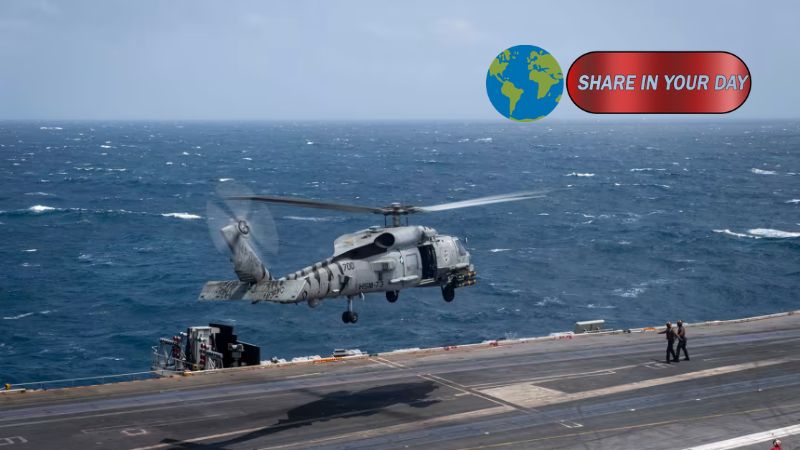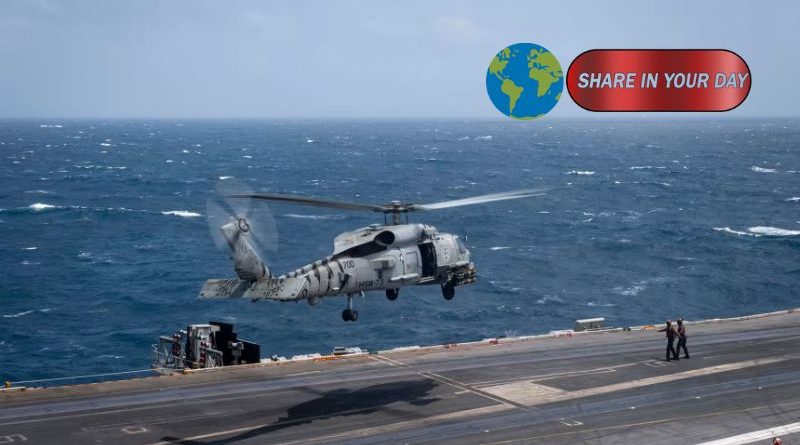US Navy Helicopter and Fighter Jet Crash in Separate Incidents in the South China Sea
In a dramatic series of events, a US Navy helicopter and a fighter jet crashed within the same half-hour on Sunday during separate routine operations over the South China Sea. Fortunately, all crew members aboard both aircraft were rescued and are reported safe.
The crashes, which occurred within a short span of time, have prompted the Navy’s Pacific Fleet to initiate an investigation into the causes behind the incidents. Both crashes occurred over the strategically critical South China Sea, a region that has long been a flashpoint for tensions between the US and China, among other nations.

Helicopter and Fighter Jet Crashes
According to the US Navy, the first incident involved an MH-60R Seahawk helicopter, which went down around 2:45 p.m. local time while conducting routine operations from the aircraft carrier USS Nimitz. Search-and-rescue teams were quickly dispatched, successfully recovering three crew members.
About 30 minutes later, an F/A-18F Super Hornet fighter jet, also operating from the USS Nimitz, crashed during its own routine mission. Both crew members ejected from the fighter jet and were safely recovered, the Navy confirmed.
The USS Nimitz, one of the largest and oldest aircraft carriers in the US Navy fleet, was reportedly conducting operations in the South China Sea at the time. This marks the latest in a string of incidents involving the Navy’s F/A-18 Super Hornet aircraft. This particular jet is the fourth of its kind the Navy has lost this year alone.
A Troubling Year for F/A-18 Jets
The F/A-18F Super Hornet has had a notably difficult year. Earlier this spring, two additional F/A-18 aircraft were lost in separate incidents. One fell off the aircraft carrier in the Red Sea, and the other suffered a malfunction with its landing system. In August, another F/A-18 crashed during a training exercise off the coast of Virginia.
Despite these setbacks, the Navy continues to operate these advanced fighter jets, which are essential for air superiority and strike operations.
Tensions in the South China Sea
The South China Sea is a region of high geopolitical tension, with several nations, including China, the Philippines, and Vietnam, asserting territorial claims. China, however, claims nearly all of the South China Sea, a stance that has been met with strong opposition from neighboring countries and the international community. An international court ruling has invalidated China’s broad claims, but Beijing has continued to build military installations on contested islands and reefs, further fueling tensions.
The US has maintained a consistent military presence in the region, conducting freedom-of-navigation operations and supporting regional allies. Washington argues that China’s territorial claims and military expansion threaten the free flow of trade and the principle of freedom of navigation in international waters.
Diplomatic Context: Trump’s Asia Tour
The timing of these incidents coincides with President Donald Trump’s ongoing diplomacy tour in Asia. Trump is set to meet with Chinese President Xi Jinping later this week for talks primarily focused on trade. The two leaders are expected to discuss a range of issues, including their ongoing trade dispute, which has seen a recent flare-up following months of relative calm.
On Sunday, US Treasury Secretary Scott Bessent confirmed that the US and China had reached a framework agreement on trade, which could help ease tensions ahead of the high-level talks between Trump and Xi.
The USS Nimitz: A Veteran Warship
The USS Nimitz, which was involved in both crashes, is the oldest aircraft carrier in active service in the US Navy. Commissioned in 1975, the Nimitz is expected to be retired next year, marking the end of an era for one of the Navy’s most iconic warships.
As investigations into both crashes continue, the Navy will likely face increased scrutiny regarding the safety of its operations, particularly in a region as contested as the South China Sea.




